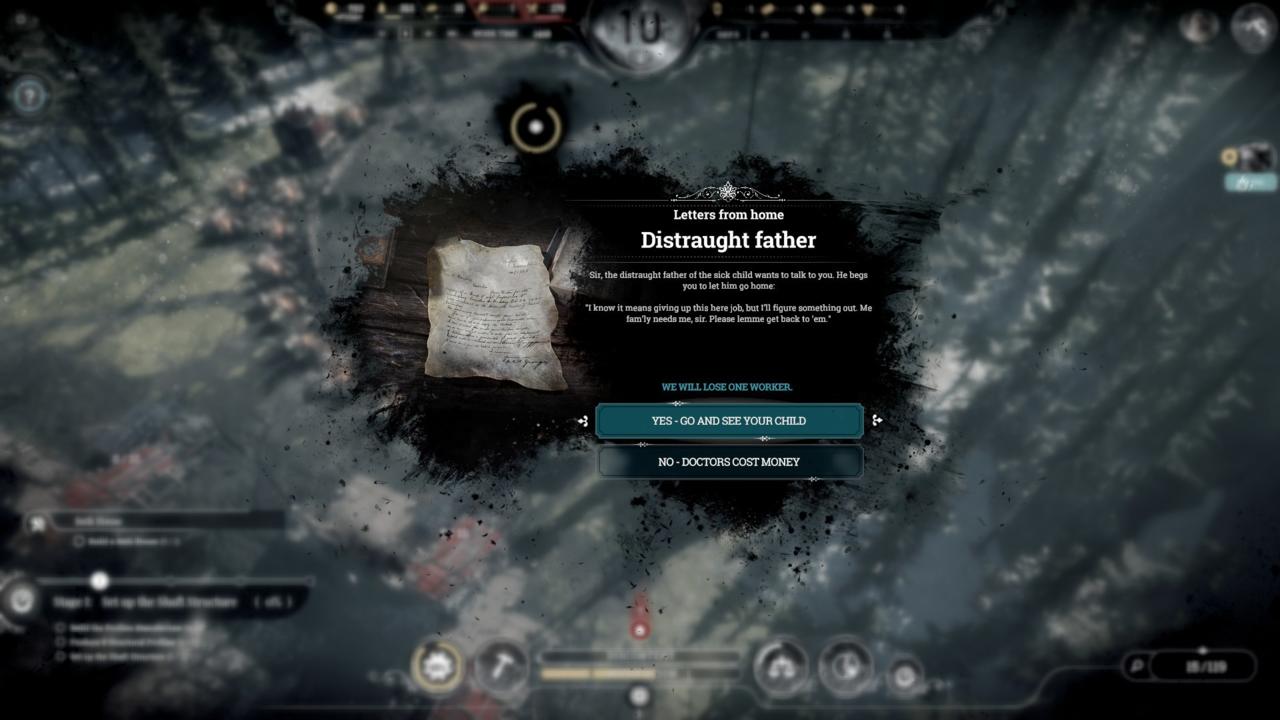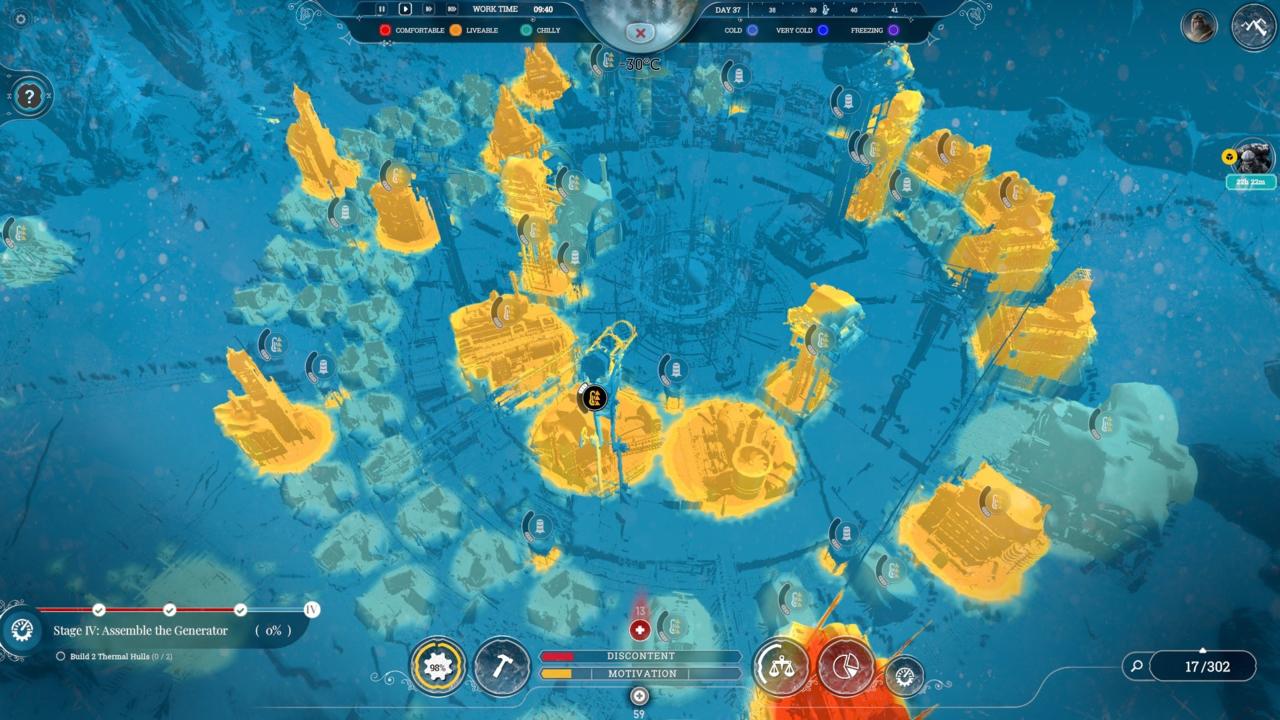In Frostpunk's main campaign, you already know the stakes. A winter of biblical proportions has descended upon Industrial Revolution England, driving its citizens into the frozen unknowns to seek out life-giving generators. In The Last Autumn, you are in charge of making one of those very generators a reality--one that will hopefully save lives in the future. Winter lies in wait on the periphery, so you have to worry about new means of resource gathering, timed objectives, and social challenges rather than staving off the flu. It dresses the familiar gameplay elements of Frostpunk up differently, demanding a new type of strategic thinking that reinvigorates the already satisfying formula at its core.
With the cold weather encroaching on Liverpool, you lead a handful of workers and engineers on an expedition to a cove on the edge of the country. Near-freezing sprays from the nearby ocean splash against treacherous rocky beaches, with only a small space to build upon peering through the thicket of trees outlining the coast. This limited space is immediately stressful--a massive generator needs to be built, resources around you already seem scarce, and the space you must work with doesn't allow for many placement mistakes. The odds are stacked against you from the start of Last Autumn's campaign, but some new tools provide reprieve in distinct ways.

Instead of gathering resources from deposits around you, you can build new harbors on limited coastline spaces to collect what you need. You have to choose which spaces are dedicated to fishing for food and which others can be set up as large ports, allowing ships with stockpiles of wood, coal, or steel to dock and unload. Shipping resources in is only one part of the supply chain, too. With new depots staffed with workers, you can quickly supply your main city with resources nearly as fast as they're unloaded, which vastly improves upon having workers manually carry them from the docks. Each of these structures requires some of your more limited resources, though, making each micro-decision carry more weight than before. When each ingot of steel feels as precious as the last, you'll rarely find yourself overwhelmed as was the case in some previous scenarios, escalating the overall tension as a result.
Other new structures are intrinsically tied to your new objective of building a central generator, each of which are used to build specific pieces of the giant contraption. You have a total of only 45 game days to achieve this goal, without any preparation time to make provisions for a stable resource supply line and citizen housing. It makes each of the four impending milestones immediately stressful, but it's all initially more confusing than it needs to be. The Last Autumn features the same useful tutorials from the main campaign to make picking up its new mechanics easy, but it doesn't do a good enough job surfacing the menus you can utilise to measure your progress towards the next milestone. It ultimately ruined my first run--I missed my first milestone without realizing that it even existed, making it impossible for me to hit subsequent ones on time before being fired. For all the good The Last Autumn does surfacing nearly every other facet of its new mechanics, it's frustrating that it takes some lost progress to truly understand its overall tempo.
Once you come to grips with the time limits imposed on you, you can focus more on The Last Autumn's new Motivation meter, which joins the returning Discontent meter from previous scenarios. Each is fairly self-explanatory--the first one measures how much motivation your workers have to get the job done, while the other indicates how unhappy they are with their current living situation. Unlike previous campaigns, though, letting either one get too high or too low doesn't end your game. Instead, Motivation determines just how efficient your workers are at the jobs they're assigned to, while Discontent alters how likely they are to put down tools entirely and walk out on strikes. Keeping Motivation high and Discontent almost non-existent at first is easy, but as the impending winter approaches and the realities of your encroaching deadlines loom, unavoidable, scenario-specific modifiers to both make their upkeep a true challenge.
Strikes are a new social aspect you'll need to contend with, going hand-in-hand with new metrics measuring the safety of workplaces in place of worrying about their overall temperature (given that winter hasn't yet arrived). Workplaces that are consistently dangerous and staffed with workers working either long or double shifts will quickly drive their occupants to down their tools and picket outside, forcing you to negotiate before returning to work. Worker requests will require you to pass new laws affecting either their work hours or living conditions, often demanding more resources from you or a tolerance for their slower pace of work in order to get them back into their factories and mills. The knock-on effects of these decisions can sometimes feel absent at first but come back around days later to haunt you, making each strike negotiation important to carefully consider. Even simply delaying your decision with handouts of rations often results in more strenuous demands from your workers, turning strikes into worthy headaches that compound the satisfyingly stressful symphony of systems present already.
With new mechanics to contend with and different ways to approach Frostpunk's strategic formula, the new laws that it introduces make tackling both as morally challenging as ever. Your base set of laws returns from previous scenarios, but the branches that come with siding with either labor or your engineers expand on them extensively. In one of my successful runs I passed laws in the engineering path that allowed me to ship in prisoners for cheaper labor, while constructing oppressive security towers and multiple penitentiaries to keep everyone in line. The authoritarian approach didn't sit well with most citizens, but it made sense to grow my workforce rapidly without needing to worry too much about the needs of my new laborers. Eventually I unlocked an ability to turn regular citizens into criminals without trial, giving me the chance to boost efficiency in workplaces solely staffed by criminals as a result of their supposed disposability.
None of these decisions are easy to make. Frostpunk has always made each of your decisions feel like choosing between two evils, and The Last Autumn maintains that. When shipping in criminals I was constantly reminded of how terrible some of their crimes were and how they might introduce problems to my other citizens if not policed correctly. But even introducing a growing security force presented issues. Empowered citizens imposed their authority incorrectly at times, which in one case drove one of my citizens to death after consistent harassment that I ignored so that my criminals could be kept in check. Seeing small stories like this emerge from decisions I made hours before was equal parts gut-wrenching and fascinating, encouraging me to explore new laws and regulations to see what effects they might have.

Because bad Motivation or Discontent don't end a run and only the stress of missing deadlines to contend with, The Last Autumn allows for more flexibility in your strategy. It lets you stretch the boundaries of what its new laws offer, offering you the chance to drive forward with increasingly morally dubious decisions if all you're focused on is getting the job done. It doesn't come without consequence, though, especially when the cold arrives near the end of the run and introduces further restrictions on resource gathering as well as the familiar temperature monitoring in workplaces and citizen residences. By the end of my own run I was furiously converting citizens into criminals to increase my workforce without new shipments of workers coming in, exponentially increasing the size of my required security force too. The last few days felt like a battle of attrition--I wasn't allowed to let up on longer shifts but also incapable of dealing with the living needs of my population without diverting resources from the work on the generator. Within just a few days nearly half my society had succumbed to illness and died, eventually allowing me to reach my goal but with hardly any of the people responsible for it alive to see the fruits of their labor.
Outside of small stories that your decisions generate and influence, The Last Autumn does attempt to conclusively confront your choices by its conclusion. With the generator built and your citizens sent to the next site that needs work, you're presented predictions for how effective your generator might be and just how many citizens it could save in the future. Based on how many milestones you missed, how many concessions you had to make to get there, and the number of people you lost along the way, the hard-fought victory might be met with depressingly low odds of success in the long run. It stings to have that presented to you after making sacrifices for what you assumed would be a greater good, forcing you to reevaluate your overall strategy and try again for a better outcome.
The Last Autumn demands a lot from you, but it's also a deeply engrossing evolution of the formula that Frostpunk is made up of, changing the core rules just enough to make all your previous strategies feel insufficient. Whether it's deciding on which resources to order and how to distribute them or which parts of your workforce to push just hard enough before they reach their breaking point, The Last Autumn maintains the morally challenging and consequence-riddled decision-making of the core game while giving you new laws to experiment with and master. It's a welcome return to an already fantastic strategy game that shouldn’t be glossed over.



















